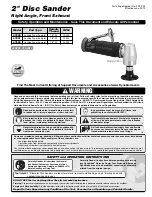
Safety, Operation and Maintenance
–
Save This Document and Educate All Personnel
Parts Page Reorder No. PD12•20
Effective June, 2012
WARNING
Read and understand this tool manual before operating your air tool. Follow all safety rules for the protection of operating personnel as
well as adjacent areas. Always operate, inspect and maintain this tool in accordance with the American National Standards Institute (ANSI).
Safety Requirements for the Use, Care and Protection of Abrasive Wheels – ANSI B7.1, Compressed Air and Gas Institute (CAGI) Safety Code
for Portable Air Tools – B186.1, Code of Federal Regulation – CFR 29 Part 1910, International Organization for Standardization (ISO) Hand
Held Non-Electric Power Tools – ISO 11148, Safety Requirements and applicable State and Local Regulations.
Find The Most Current Offering of Support Documents and Accessories at www.Dynabrade.com
Read and understand tool manual before work starts
to reduce risk of injury to operator, visitors, and tool.
Ear protection to be worn when exposure to sound,
exceeds the limits of applicable Federal, State or
local statues, ordinances and/or regulations.
Practice safety requirements. Work alert, have proper
attire, and do not operate tools under the influence
of alcohol or drugs.
Air line hazard, pressurized supply lines and flexible
hoses can cause serious injury. Do not use damaged,
frayed or deteriorated air hoses and fittings.
Eye protection must be worn at all times, eye
protection to conform to ANSI Z87.1.
Respiratory protection to be used when exposed to
contaminants that exceed the applicable threshold
limit values required by law.
Some dust created by sanding, grinding, drilling, and other construction activities contain chemicals known to cause cancer, birth defects
or other reproductive harm. Some examples of these chemicals are:
• Lead from lead-based paints
• Crystalline silica from bricks and cement and other masonry products
• Arsenic and chromium from chemically treated lumber
Your risk from these exposures varies, depending on how often you do this type of work. To reduce your exposure to these chemicals: work in a well
ventilated area, and work with approved safety equipment, such as those dust masks that are specially designed to filter out microscopic particles.
SAFETY and OPERATING INSTRUCTIONS
DO NOT USE Tool for Anything Other Than Its Intended Applications.
Training:
Proper care, maintenance, and storage of your air tool will maximize tools performance and reduce chance for accident.
Employer's Responsibility:
Provide operators with safety instructions and training for safe use of tools and accessories.
Report to Your Supervisor any Condition of the Tool, Accessories or Operation you Consider Unsafe.
Tool Intent:
2" Diameter Disc Sanders are ideal for material removal and finishing using 2" Backup pads with
appropriate sized abrasives.
Carefully Read and Understand the General
and Sander/Polisher sections found in Tool
Safety and Operating Guidelines (PN00001676)
Before Handling or Using Tool.
Carefully Read all instructions before operating or servicing
any Dynabrade
®
Abrasive Power Tool. Products offered by
Dynabrade are not to be modified, converted or otherwise
altered from the original design.
Model
Pad Type
Spindle
Thread
RPM
47820
Locking-Type (Female)
1/4"-20
12,000
47821
Locking-Type (Female)
1/4"-20
15,000
47822
Locking-Type (Female)
1/4"-20
20,000
2" Disc Sander
Right Angle, Front Exhaust
SANDER / POLISHER
Model 47820






















